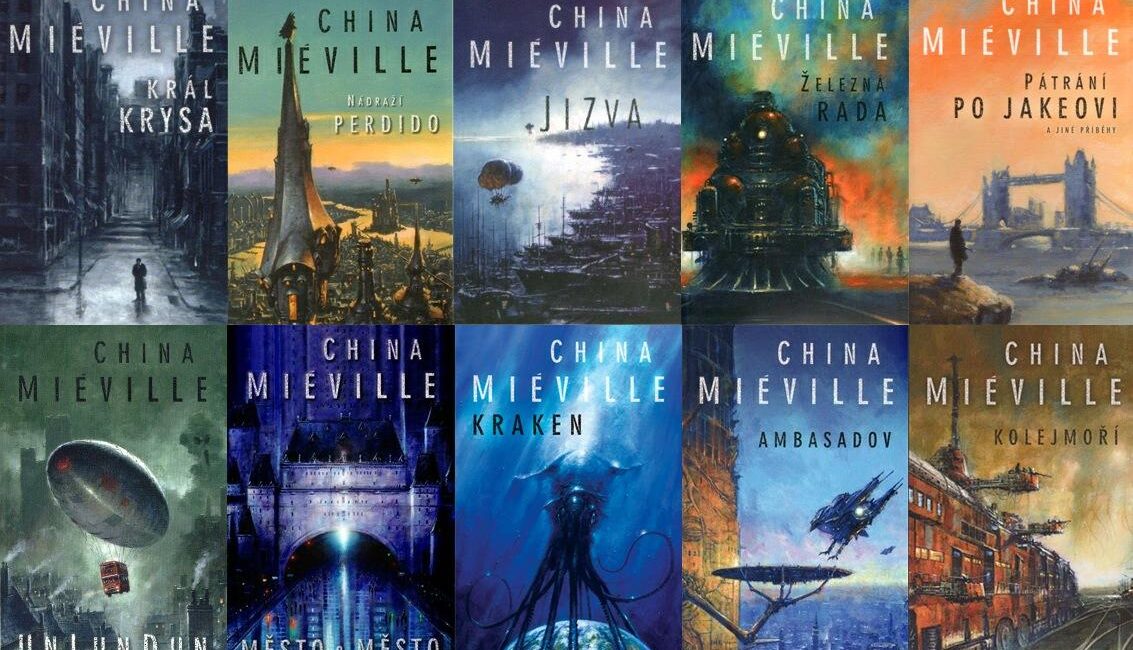Unraveling the captivating literary journey of China Miéville entails more than just listing his works. It’s about diving into the multifaceted worlds he creates, exploring the amalgamation of fantasy, science fiction, and socio-political depth within his narratives. Delve into the countdown of his top-ranked books, as evaluated across Goodreads, Amazon, and LibraryThing.
The Rankings Unveiled
China Miéville has a fantastic taste in literature, often delving into the realms of speculative fiction, weird fiction, and fantasy. Miéville has expressed admiration for various authors and books in these genres. Some of his top picks or influences might include:
20. This Census-Taker
A lonely boy’s traumatic event sets the stage for an encounter that could shatter his isolation. But who holds the authority behind the meticulous records? “This Census-Taker” is a novella by China Miéville. It’s a mysterious and atmospheric story that revolves around a boy who witnesses something traumatic in his family home and then encounters a stranger, leading to the boy’s involvement with a census-taker.
The narrative is haunting and enigmatic, leaving much to the reader’s interpretation. It’s a departure from Miéville’s usual intricate world-building, instead focusing on a more introspective and psychological storyline. The novella plays with ambiguity and symbolism, inviting readers to ponder its deeper meanings rather than providing straightforward answers.
Miéville’s writing style in “This Census-Taker” showcases his ability to craft compelling, atmospheric narratives that linger in the mind, even though it might be different from his more sprawling and elaborate works.
19. King Rat
London’s dark secrets intertwine with Saul’s royal heritage, propelling him into a world beneath the streets and a plan for revenge. “King Rat” is China Miéville’s debut novel, published in 1998. It’s a blend of urban fantasy, dark fiction, and a reimagining of the Pied Piper legend set in contemporary London.
The story follows the protagonist, Saul Garamond, a young man who discovers his heritage tied to the Rat King, a figure of urban legend and mythic power. Saul finds himself embroiled in a conflict between the Rat King and a rival entity, leading to a journey through London’s underground realms, both literal and metaphorical.
Miéville’s “King Rat” combines elements of fantasy with the grittiness of urban life, presenting a unique spin on familiar folklore. It showcases his early talent for crafting inventive, dark, and atmospheric narratives, setting the stage for his later works known for their imaginative world-building and unconventional storytelling.
18. Kraken
In an outrageous and surreal London, a cephalopod specialist’s tour takes an unexpected turn when a prized specimen vanishes. “Kraken” is a standalone novel by China Miéville published in 2010. Set in a fantastical version of London, the story is a blend of urban fantasy, supernatural thriller, and surrealism.
The plot revolves around the theft of a preserved giant squid from London’s Natural History Museum, which sets off a series of bizarre events. Billy Harrow, a museum curator, gets embroiled in this mystery and discovers an underground world of cults, magic, and fantastical creatures existing within the city’s shadows.
Miéville uses “Kraken” to explore a wide range of themes, including cults, mythology, and the power of belief. The novel showcases his trademark imaginative world-building and inventive storytelling, interweaving various elements of fantasy and the supernatural into a fast-paced and surreal narrative set against the backdrop of London’s diverse landscapes.
17. Three Moments of an Explosion: Stories
London faces inexplicable phenomena and unforgettable images in this collection of twenty-eight speculative, satirical, and heart-wrenching stories. Three Moments of an Explosion: Stories” is a collection of short stories by China Miéville, published in 2015. The anthology features a diverse array of speculative fiction tales that span various genres, from science fiction and fantasy to weird fiction and horror.
Each story in the collection presents a unique premise and setting, often delving into unconventional and thought-provoking concepts. Miéville’s storytelling prowess shines through the exploration of unusual ideas, intricate world-building, and compelling characters across these diverse narratives.
The collection offers a glimpse into Miéville’s versatility as a writer, showcasing his ability to craft immersive and intellectually stimulating stories that challenge readers’ perceptions and expectations of the speculative fiction genre.
16. The Last Days of New Paris
The convergence of wartime chaos, occultism, and surrealism leads to a world-changing power, altering the course of history. The Last Days of New Paris” is a novella by China Miéville, released in 2016. Set in an alternate history during World War II, the story unfolds in Paris, which has become a battleground for surrealistic manifestations.
In this alternate reality, a detonation known as the S-Blast has unleashed bizarre and dangerous entities, bringing surrealist artworks to life and warping reality. Amidst this chaos, the city becomes a zone of eerie and fantastical occurrences where art and reality blur in unsettling ways.
15. Dial H
Nelson, an unemployed slacker, discovers a broken-down payphone that transforms him into various superheroes with a twist of the dial. Dial H” is a comic book series written by China Miéville for DC Comics as part of their “New 52” initiative, first published in 2012. It’s a modern reimagining of a classic DC concept where an ordinary person gains superpowers by dialing an otherworldly H-Dial.
The series follows Nelson Jent, an overweight and out-of-shape man who accidentally discovers the H-Dial. When he uses it, he transforms into a random superhero for a limited time, each with unique powers and designs. Alongside his friend, Manteau, who also has a connection to the H-Dial, Nelson embarks on adventures while grappling with the consequences and mysteries behind the device.
14. Iron Council
In a time of wars and revolutions, New Crobuzon teeters on the brink, pushing a small group of renegades on a desperate quest. “Iron Council” is a novel by China Miéville, published in 2004. It’s the third book set in the world of Bas-Lag, following “Perdido Street Station” and “The Scar.”
The story revolves around a group of rebels, workers, and outcasts who come together to create the Iron Council, a train that travels endlessly across the vast and chaotic landscape of Bas-Lag. The Iron Council represents both a physical train and a symbol of rebellion against authority and oppression.
13. Pathfinder Chronicles: Guide to the River Kingdoms
Thieves, brigands, and desperate inhabitants flock to the River Kingdoms, where power is determined by brute strength. The “Pathfinder Chronicles: Guide to the River Kingdoms” is a supplement book for the Pathfinder Roleplaying Game, an extensively popular tabletop roleplaying game. However, it’s important to note that China Miéville isn’t credited as the author or creator of this particular guide. Miéville is known for his novels and contributions to speculative fiction rather than RPG supplements.
12. Looking for Jake
A groundbreaking collection of stories, offering a glimpse into Miéville’s fiercely imaginative world, including tales from New Crobuzon. “Looking for Jake” is a collection of short stories by China Miéville, published in 2005. The book comprises various speculative fiction tales, exploring themes ranging from urban unease to surreal and fantastical elements.
11. The Worst Breakfast
Two sisters describe the weirdest, yuckiest breakfast, leading to an unexpected turn of events. The Worst Breakfast” is a short story by China Miéville, included in his collection “Looking for Jake,” published in 2005. In this story, Miéville explores a surreal and unsettling scenario where the protagonist, after waking up, finds that the world has been transformed in bizarre ways.
10. The Tain
“The Tain” is a novella by China Miéville, included in his collection “Looking for Jake,” published in 2005. The story is a homage to Irish mythology, specifically referencing the Irish epic “Táin Bó Cúailnge” (“The Cattle Raid of Cooley”).
In Miéville’s “The Tain,” the narrative is set in a city besieged by a bizarre and incomprehensible invasion. Strange and surreal creatures, known as the “Knackers,” raid the city, causing chaos and destruction. The story follows Sholl, a young boy, and his experiences amidst the chaos, encountering the peculiar and unsettling world of the Knackers.
9. Embassytown
“Embassytown” is a science fiction novel by China Miéville, published in 2011. It’s set in the distant future on a distant planet called Arieka, where humans coexist with an enigmatic alien species known as the Hosts.
The story follows Avice Benner Cho, who grew up in Embassytown, a human colony on Arieka. The Hosts communicate in a unique and complex language that only a few specially trained individuals, known as Ambassadors, can understand. Avice becomes embroiled in a crisis when a new Ambassador arrives, causing unforeseen disruptions in the delicate balance between humans and Hosts.
8. Un Lun Dun
Un Lun Dun” is a young adult fantasy novel by China Miéville, published in 2007. It’s a departure from Miéville’s usual darker and more complex themes, presenting a whimsical and imaginative story suitable for younger readers.
The narrative follows two girls, Deeba and Zanna, who stumble into UnLondon, a fantastical and alternate version of London. In UnLondon, they encounter a world of oddities, inhabited by creatures and objects with lives of their own. They soon discover that Deeba might be the “Shwazzy,” the chosen one destined to save UnLondon from a dangerous threat known as the Smog.
7. October: The Story of the Russian Revolution
October: The Story of the Russian Revolution” is a non-fiction book by China Miéville, published in 2017. Unlike his usual speculative fiction works, this book delves into historical analysis.
“October” provides an in-depth examination of the Russian Revolution of 1917, focusing specifically on the October Revolution that led to the Bolsheviks taking power. Miéville offers a detailed and vivid account of the events, exploring the social, political, and economic factors that contributed to this pivotal moment in history.
6. The City & the City
The City & the City” is a novel by China Miéville, published in 2009. It’s a blend of speculative fiction, detective noir, and political allegory set in two fictional cities, Besźel and Ul Qoma, which exist in the same geographical space but have distinct cultures, languages, and customs.
The story follows Inspector Tyador Borlú of the Extreme Crime Squad in the city of Besźel. When a murder investigation leads him to uncover a complex conspiracy that crosses the boundaries between Besźel and Ul Qoma, Borlú navigates the intricate rules and tensions between these twin cities.
5. Perdido Street Station
“Perdido Street Station” is a novel by China Miéville, published in 2000. Set in the fictional city of New Crobuzon, it’s a dark and sprawling tale that blends elements of fantasy, steampunk, and weird fiction.
The story follows Isaac Dan der Grimnebulin, a scientist who becomes involved in a dangerous experiment to help a wingless bird-like creature regain its ability to fly. This experiment inadvertently leads to catastrophic consequences as it unleashes a terrifying and powerful force upon the city.
4. Railsea
“Railsea” is a young adult novel by China Miéville, published in 2012. It’s a unique and inventive take on the adventure genre, blending elements of steampunk, dystopia, and fantasy.
The story is set in a vast desert known as the Railsea, a landscape crisscrossed by an intricate network of railway lines. The protagonist, a young apprentice named Sham Yes ap Soorap, embarks on a journey aboard a moletrain, a vehicle used for hunting gigantic burrowing creatures
3. Between Equal Rights: A Marxist Theory of International Law
“Between Equal Rights: A Marxist Theory of International Law” is a non-fiction book written by China Miéville, published in 2005. In this work, Miéville explores and critiques the concept of international law from a Marxist perspective.
The book examines the nature of international law and its relationship to power structures, capitalism, imperialism, and class struggle. Miéville engages with Marxist theory to dissect how international law often serves the interests of powerful nations and maintains existing global hierarchies.
2. Red Planets: Marxism and Science Fiction
“Red Planets: Marxism and Science Fiction” is a collection of essays edited by Mark Bould and China Miéville, published in 2009. The book explores the intersection of Marxism and science fiction, examining how these two realms intersect and influence each other.
The essays within “Red Planets” delve into various aspects of science fiction literature and its relationship with Marxist thought. They analyze how science fiction can be a vehicle for exploring social, political, and economic ideas, including issues of class struggle, utopian societies, and dystopian futures.
1. The Scar
Aboard a seafaring vessel, a band of prisoners embarks on a journey intertwined with pirates, survival, and the enigmatic duality of the Lovers. “The Scar” is a novel by China Miéville, published in 2002. It’s the second book set in the world of Bas-Lag, following “Perdido Street Station.”
The story takes place in a different region of Bas-Lag and follows Bellis Coldwine, a linguist from the city of New Crobuzon, who flees after a crisis and finds herself aboard a floating city called Armada. Armada is a collection of ships linked together, a motley flotilla of various cultures and species.
Conclusion
China Miéville’s bibliography isn’t just a list of books but a portal into diverse realms, blending genres and pushing boundaries. The rankings offer a guide, but the true essence lies in the exploration, where each narrative stands as a unique testament to Miéville’s imaginative prowess. Happy exploring!



